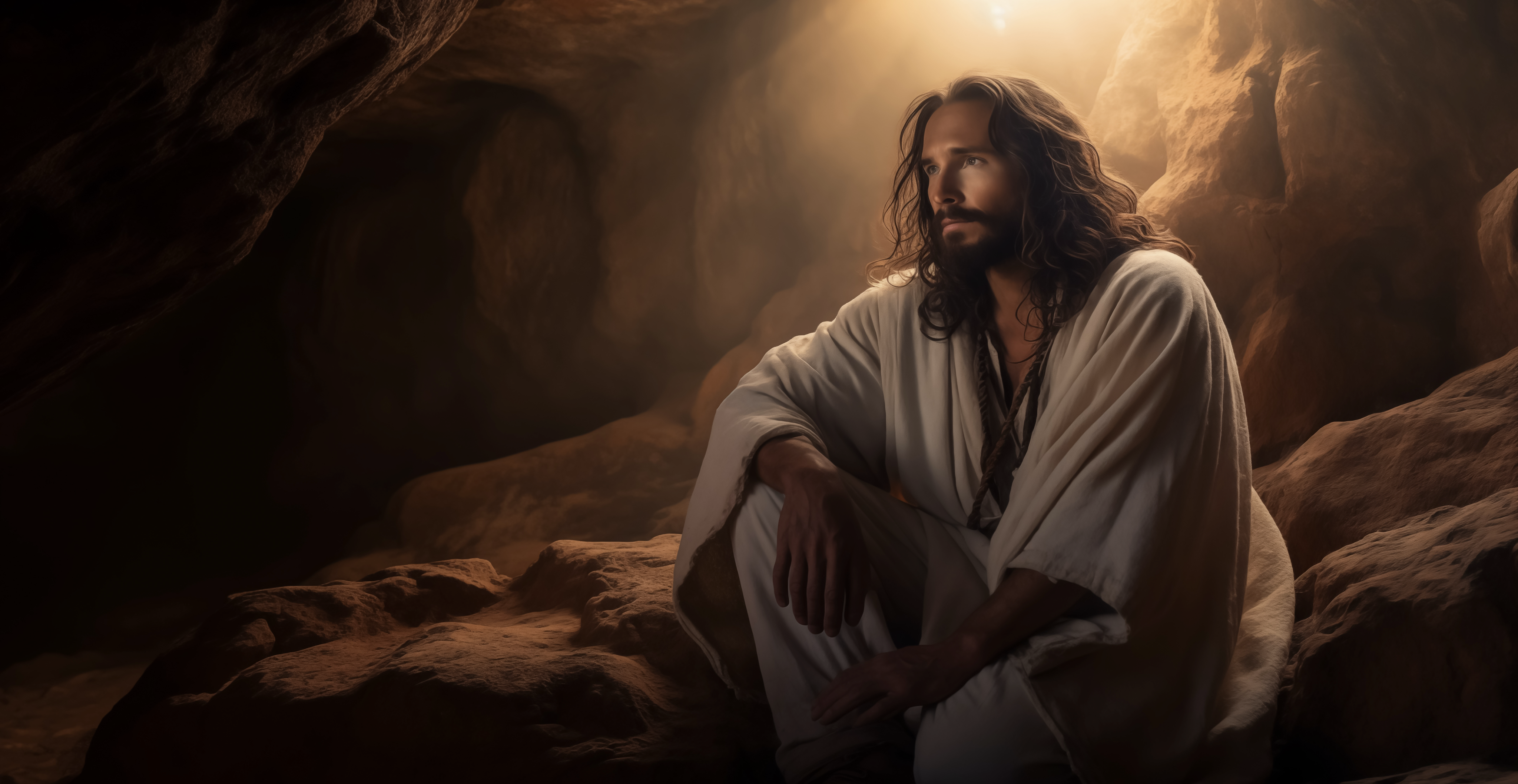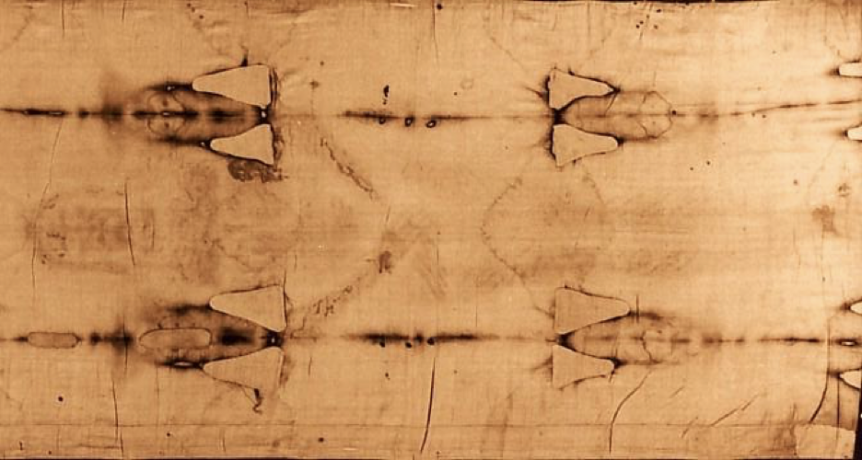“The Shroud presents an extreme either-or proposition: It either is the actual burial shroud that wrapped Jesus in the tomb, or it is the greatest hoax ever perpetrated. There is nothing in between.”
– Russ Breault, Shroud Expert, Investigator
Presented here is a highly controversial topic! Look between the patches and water marks to see the image. I’ve put together narrative, links, and research sources for you to draw your own conclusion…
What is the Shroud?
The Shroud of Turin is an ancient burial cloth that has “imprinted” on it the life-size image of a crucified man. I use “imprinted”, as in “to fix indelibly or permanently”, for want of a better word, since no one has been able to explain how the image appeared on the cloth. It is called the “Shroud of Turin” because it currently resides in the Cathedral of Saint John the Baptist, in Turin, Italy.
It came to light in the Middle Ages, although there is compelling evidence to suggest that it existed and was “hidden” before this time. When it was photographed for the first time in 1898, it was discovered that the image is actually a photographic negative, which is remarkable in itself since the Shroud is known to have been in existence hundreds of years before the invention of photography. In other words, what should be the positive image on the Shroud is very faint, but the negative image looks like an actual photograph. This suggests the image was made by some kind of light source—one of several theories.
Because of the unique characteristics of the image, it has been linked to the crucifixion of Jesus Christ, which is described in Matthew 27, Mark 15, Luke 23, John 19. John’s account is the most detailed.
The Shroud has survived at least two fires, and over the years has been carefully patched and repaired along the edges. The figure looks strange and flattened but the 3-D rendering is much more revealing.
The Cloth
The cloth which bears the image is fourteen and one half feet long, and three and one half feet wide. It is made of linen and is consistent with cloth manufactured in the Middle East. The body appears to have been laid on one half of the cloth with the other half folded over the head and laid on top. The image on the cloth shows the front and back of the body. Scientists have identified pollen on the cloth from the Palestine area, as well as from regions through which the Shroud is thought to have been carried. Dirt on the feet and the front of the nose, where the man apparently fell face-first, has been detected on the cloth, which scientists confirm is also from the Palestine area, and specifically, from the Damascus Gate area in Jerusalem. The initial carbon dating, later shown to be flawed, dated the cloth from the Middle Ages.
No paints or pigments have been detected on the cloth, and the water used to douse a fire left only water stains, with no running of any other liquid substance.
The first known public exhibitions of the Shroud began in 1355. Its history before that time is unknown, although much research and study has been done by scholar Ian Wilson. He, among others, believes that the Shroud is the same as what was called the “cloth, or image, of Edessa”, also known as the Mandylion, which was a framed “portrait” strongly resembling the head of the man on the Shroud, often appearing in public exhibitions prior to the Middle Ages. It is theorized that the Shroud had been folded so that only the face showed within the frame. There are many medieval works of art attesting to the existence of this cloth. Before that time, it is believed that the Shroud was continuously hidden by Jesus’ disciples, namely in the city of Edessa, Turkey (known today as Urfa), and Constantinople (known today as Istanbul.)
Briefly, the documented history of the Shroud began in 1349 when a French knight was known to be in possession of the Shroud, which he could possibly have acquired in Constantinople after the city was sacked by Crusaders. In spite of efforts by the Catholic church to obtain ownership of the Shroud, it continued to be owned and passed down within private families until 1983. At that time the current owner died, bequeathing the Shroud to the Pope “and his successors”, providing that the cloth remain in Turin.
In 1978, the Shroud was closely examined by a team of scientists. This was called the Shroud of Turin Research Project (STURP).
The Image

The image is that of a bearded man, approximately six feet tall, who has been beaten severely about the face, scourged, stabbed in the side, and has had some sharp object pressed upon his head which left puncture wounds. There are abrasions which left practically no skin on his shoulders where he may have carried a heavy object, and on his knees, as the probable result of one or more hard falls. There are puncture wounds in the palms/wrists and feet. Parts of his beard have been torn out.
The more than one hundred scourge marks are consistent with the Roman flagrum, which was a whip containing pieces of metal and bone. There are indications of the flesh being literally ripped out.
Whoever the man of the Shroud was, he was brutally beaten and mutilated, which had to have been almost to the point of death, even before he was affixed by nails to what is consistent with the properties of a cross due to the direction of the blood flow from the wrist wounds. The image suggests that rigor mortis has set in and the knees are slightly raised.
Some scientists claim to be able to see coins placed over the eyes of the man with inscriptions dating to the first century. Thus far, this is inconclusive.
What caused the image to appear on the cloth? No one has been able to duplicate such a unique image using a corpse, or by any other mechanism. If modern technology has failed, we can presume any method of producing the image would not have been available during the Middle Ages.
Many Christian scholars and scientists theorize the image was created by some kind of light at the moment of resurrection, assuming that the image is indeed that of Jesus Christ. Interestingly, some believe the “light”, or radiation, came from inside the body, rather than from outside.
The Blood
Testing shows that the blood stains on the Shroud contain hemoglobin and serum albumin. They also contain bilirubin, which is produced in the human body by traumatic injury.
There have been several headlines in recent news that the bloodstains cannot be authentic, due to comparing blood splatter with the positioning of the body on the cloth. Conversely, studies were done by experts decades earlier, which indicate that the blood flow patterns perfectly match the way a body would hang on a cross.
The Carbon Dating Scandal
In 1988, the Vatican agreed to allow carbon 14 dating of the Shroud. A sample was taken, and the results seemed to show that the cloth was only a few centuries old, dating from 1260 to 1390 AD. The authenticity of the Shroud was effectively debunked. However, due to the efforts of many carbon dating skeptics, the entire process was shown to be flawed and the results have since been in serious doubt.
The sample used for the carbon dating test was taken from the very edge of the cloth, which was not only contaminated by much handling, but had actually been “repaired” by well-meaning persons who were trying to match the appearance of the main part of the Shroud, including the intertwining of original linen fibers with procured cotton fibers, and dying the cotton to match the linen.
Even though carbon dating has often been found to be in error, it seems that it may not have been the chemical process here that was at fault, but the location of the sample that was taken. The plea to use multiple samples had been declined or ignored by the Shroud custodians.
Many other contaminants could be listed which would skew testing results of any part of the Shroud, including the heat of the fires to which it has been exposed, water dousing (which can alter results by hundreds of years), and even the unknown mechanism by which the image appeared.
The Sudarium
The Sudarium of Oviedo is a napkin, or head cloth, which has been linked to the Shroud of Turin and now resides in a cathedral in Oviedo, Spain. It does not contain an image, but is believed to be the cloth that was placed over Jesus’ head after his removal from the cross to staunch the flow of fluid from his nose and mouth. John 20:7 – “And the napkin, that was about his head, not lying with the linen clothes, but wrapped together in a place by itself.” The Sudarium of Oviedo.
RECENT HISTORICAL INVESTIGATIONS ON THE SUDARIUM OF OVIEDO
Conclusion
There are many aspects of the Shroud that cannot be understood or explained. Skeptics will always seek ways to disprove its authenticity, just as believers will try to prove it. Since it is impossible to prove the Shroud is genuine, the burden of “disproof” falls on the skeptics.
Every time the skeptics make a “discovery”, such as with the skewed carbon 14 dating and the theory on the blood patterns, the news is quick to proclaim, “Shroud of Turin Proved to Be a Hoax!”
The subject of the Shroud is in no way to be related to the various “hoaxes” about religious objects and theories presented by author Dan Brown and others. This particular artifact is obviously real and has been thoroughly vetted. If it’s ever proven beyond the shadow of a doubt to be a hoax, especially considering what a forger would have to know to create it (see the link below), I have to say it wouldn’t affect my faith. I worship the Son of God, not His shroud!
In one of the videos referenced below, it was attempted to show what Jesus may have looked like according to the characteristics of the man on the Shroud. But as one wise young woman said: “It doesn’t matter how he looked, it’s what he did that counts.”

MORE INFORMATION FOR SERIOUS STUDENTS OF THE SHROUD:
Websites:
https://shroudencounter.com/what-is-the-shroud-of-turin/ The scientific and chronological history.
https://www.historian.net/shroud.htm Be sure to look at the END of this web page for what any forger would have to know before being able to create this image!
http://www.shroud.com/ Official Shroud website with photos and links to scientific papers and articles.
http://www.datingtheshroud.com/Pages/Events.htm Article on the flawed carbon dating of the Shroud.
http://www.shroud.com/bucklin.htm Medical analysis of how Jesus died.
Videos:
Real Face of Jesus from the Shroud of Turin This is a 3-D, photographic rendering of the image.
https://prophecywatchers.com/videos/russ-breault-the-mystery-of-the-shroud/ This can be viewed on the PW website or YouTube.
A Scientific View of the Shroud of Turin. Audio quality not very good but extremely interesting and informative. The speaker knows his subject inside and out. Be patient, almost 2 hours long.
Books:
The Shroud: The 2000-Year-Old Mystery Solved by Ian Wilson.
The Shroud of Turin and the C14 Dating Fiasco by Thomas W. Case.
The Blood and the Shroud: New Evidence that the World’s Most Sacred Relic is Real by Ian Wilson.
Unlocking the Secrets of the Shroud by Gilbert Lavoie, M.D.
List of books and DVDs about the Shroud by Russ Breault and others, Prophecy Watchers website.
Movie:
“The Passion of the Christ” (GRAPHIC, DISTURBING: NOT FOR CHILDREN). Directed by Mel Gibson, starring Jim Caviezel as Jesus Christ. More realistic than any other movie I’ve seen about the crucifixion. Caviezel’s performance is outstanding!
OTHER RESOURCES:

